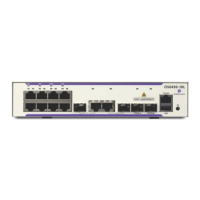Configuring Multi-chassis Link Aggregation MC-LAG Packet Flow
OmniSwitch AOS Release 7 Network Configuration Guide March 2011 page 8-19
MC-LAG prevents MAC
A
from being learned on the VFL ports of switch M
2
but shows MAC
A
as learned
on the L
A
aggregate even though the original ARP request packet was actually received through the VFL.
The MAC addresses learned on MC-LAG ports in one switch are learned on the same MC-LAG ports on
the peer switch.
4 Step 4: ARP Reply
• Switches M
1
and M
2
do not respond to the ARP request because the destination IP address (IP
B
) is not
an IP address of any of either of their IP interfaces.
• Eventually, the ARP request will reach the destination host B, which will respond to the ARP request
as indicated below.
ARP Reply Over MC-LAG
The ARP reply is a unicast packet as follows.
• Source MAC = MAC
B
• Destination MAC = MAC
A
5 Step 5: MAC
B
Learning
As the ARP reply packet traverses the system on its way back via the path Host B ==> S
2
==> M
1
=> S
1
=> Host A, the MAC
B
address is learned by the M
1
switch on the aggregate L
B
.
6 Step 6: Regular Traffic Flow
The packet eventually reaches the Host A. From this moment on, Host A will be able to communicate with
Host B using IP over the Layer 2 multi-path infrastructure provided by the MC-LAG aggregates.
Key Points
• The MC-LAG peers perform only Layer 2 switching and learning operations despite the fact that actual
traffic flowing between the hosts is IP-based.
• MAC addresses learned on an MC-LAG aggregate on one of the MC-LAG peers are also learned on
the other peer on the same MC-LAG aggregate.
M
1
S
1
MC-LAG-A
M
2
S
2
Host B
(MAC
B
, IP
B
)
MC-LAG-B
ARP Reply
L
A1
L
A2
L
B1
L
B2
MAC Table
MAC
A
⇒ L
A
MAC
B
⇒ L
B
MAC Table
MAC
A
⇒ L
A

